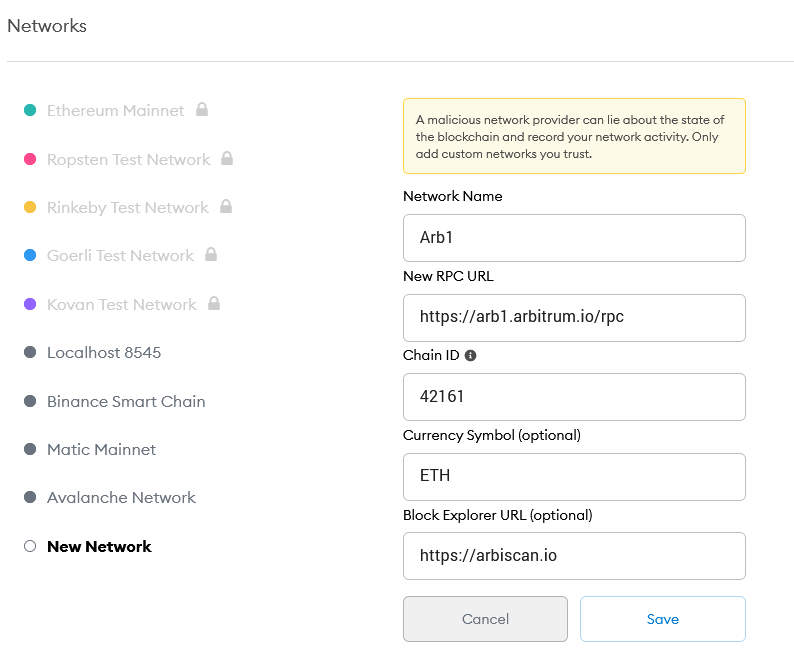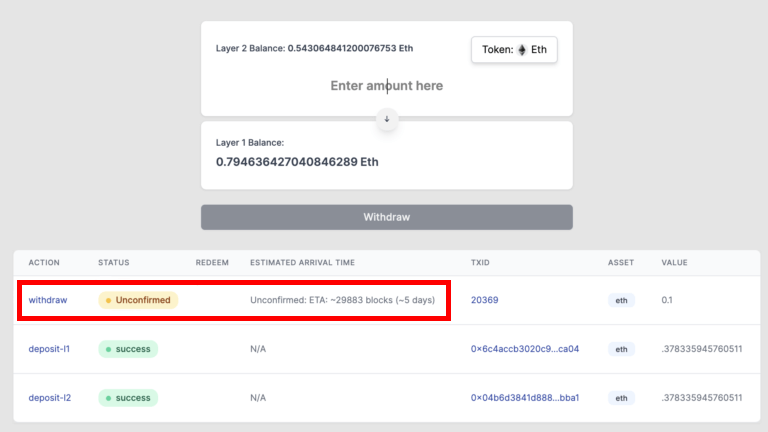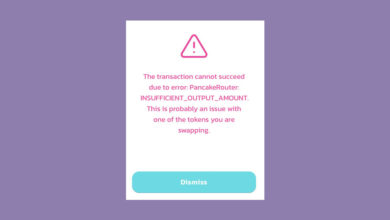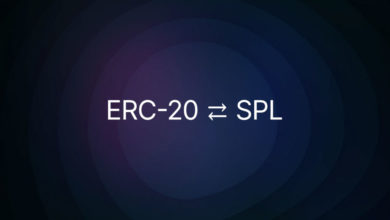How to add Arbitrum to Metamask wallet & bridge ETH from L1 to L2
Arbitrum is a layer 2 scaling solution for Ethereum that makes smart contracts scalable, fast and private.
Recently Arbitrum is one of the most hyped things in the DeFi space. A Lots of Ethereum protocols, wallets and tools went live on Arbitrum. Also a lot many popular projects already announced support for Arbitrum.
To get started using Arbitrum and to experience the infrastructure and DApps that are live on Arbitrum you need a Web 3 wallet such as Metamask.
Here in this beginners guide we’ll show you how to connect your Metamask wallet to Arbitrum one mainnet. Also we’ll explain how to move tokens from Ethereum mainnet over to the Arbitrum L2 network so you can enjoy cheap fees & fast transactions.
Now before we see how to setup and use metamask for Arbitrum let’s first understand what is Arbitrum, what it does and how it works. If you do not want to read all of that then jump to Metamask Arbitrum section here where we explained how to add Arbitrum to Metamask and transfer funds from L1 to L2.
Ethereum’s scaling issues
We all know that Ethereum is the most popular platform for building and developing decentralized applications (DApps). With all the DeFi and NFT stuffs exploding in popularity Ethereum has become the dominant settlement layer for decentralized economy in the recent times.
However the problem is Ethereum is a blockchain where the block spaces are limited and they can only support limited number of transactions at a time. The dramatic surge in user adoption and the network’s limited block space have pushed the network to its absolute limits and that often congested the Ethereum blockchain. This has lead to poor user experience as conducting transactions on Ethereum blockchain became an expensive task and oftentimes slower.
To address this issue, Ethereum developers are working on a scaling method known as on-chain sharding that splits the Ethereum network into multiple “shards.” While this on-chain tweaks and upgrades are still under development to solve the scaling issues currently the community is turning towards off-chain solutions also known as layer-two (L2) or second layer solutions.
These layer two (L2) solutions are built on top of Ethereum and they are designed mostly to solve the Ethereum’s scaling issues. One such popular L2 solution for Ethereum is Arbitrum which is developed by Offchain Labs – A New York-based development firm whose vision is to scale Ethereum and provide gas relief to the Ethereum community.
Arbitrum is a L2 roll-up technology that ’s quickly gaining traction due to its novel solution to the Ethereum’s scaling problem.
What is Arbitrum?
Arbitrum is an Optimistic Roll-up built to scale Ethereum. It is designed to address some of the shortcomings of the Ethereum smart contracts mainly being poor efficiency, and high execution costs.
It is a next generation L2 solution for Ethereum DApps that solves Ethereum’s scaling issues without compromising on the security. Not only it drastically improves the speed, scalability and efficiency of the Ethereum applications but it also adds in additional privacy features to the ecosystem.
With Arbitrum you can use your favorite tools and scale DApp at the lowest cost; all while still benefiting from Ethereum’s layer 1 security. Also since it is compatible with the Ethereum Virtual Machine (EVM) anything that is on Ethereum can simply be moved to Arbitrum and back. It can be a smart contract or a token.
The Arbitrum layer 2 offers the following advantages: Trustless security, EVM (Ethereum Virtual Machine) compatible, privacy, high scalability and low transaction costs.
How does Arbitrum work?
Arbitrum uses a type of technology known as optimistic rollup. This layer 2 solution allows Ethereum smart contracts to scale by passing messages between smart contracts on the Ethereum main chain and those on the Arbitrum second layer chain.
The Arbitrum platform allows developers to easily run unmodified EVM smart contracts and Ethereum transactions on its second layer. Most of the transaction processing is completed on the Arbitrum Layer 2 and only the results are recorded on the main chain. This makes the transactions on Arbitrum significantly cheaper than Ethereum all while maintaining decentralization and also benefiting from the Ethereum’s security.
Optimistic rollups has two main advantages: Lower off chain computation costs and low fixed-gas costs per transaction. Also since Optimistic rollups are compatible with Ethereum Virtual Machine any DApps that are on the L1 can easily carry their projects over to the Arbitrum L2
You can learn more about Arbitrum on the official website: https://arbitrum.io/
Switching to Arbitrum
Most projects that are on Ethereum have already made a switch and are also planning to switch to Arbitrum mainly because of the scaling and gas fee problems on ETH. Running DApps on L2 helps developers to scale their projects.
Uniswap community voted to launch on Arbitrum. Also many other popular Ethereum DApps like SushiSwap, Aave, Curve, CREAM, DODO Balancer and dozens of others projects are moving to Arbitrum. Not only DApps and tokens are switching to Arbitrum network but even sites like Etherscan plans on supporting the Arbitrum chain through their platform.
Its easy for both developers and users to switch from L1 to L2 and from L2 back to L1.
To switch from Ethereum L1 to Arbitrum L2 you need to connect your Ethereum wallet such as Metamask to the Arbitrum one chain. Once connected to the Arbitrum network you can use the Arbitrum bridge to move tokens from one chain to another.
Now “Arbitrum One” is the name of the first public mainnet for Arbitrum which went live on 1 Sept 2021. Its a permission-less Ethereum layer 2 with full Ethereum smart contract functionality. Its similar to Matic (Polygon) – A layer 2 that requires bridging assets to its network except it doesn’t require its own token.
In fact there is no official Arbitrum token. Anything that is claiming to be an Arbitrum token is a scam. ETH is the native currency of Arbitrum. So for any transaction or smart contract execution on the Arbitrum chain users only need Ether (ETH) for paying gas fees (ArbGas). Because Arbitrum has not launched its own token yet and it only uses ETH as its main currency.
Alright! Let’s now connect metamask wallet to Arbitrum one mainnet.
How to add Arbitrum One Network to Metamask
This tutorial assumes that you have your web3 wallet Metamask ready. Also we are assuming that have some Ether (ETH) in your Metamask wallet on the Ethereum mainnet. If you don’t have Metamask ready then go through this guide that explains how to setup Metamask extension.
Getting Arbitrum on Metamask
Getting Arbitrum on Metamask is simple and is same as adding any other EVM blockchains. All you need to do is enter the network details on Custom RPC addition feature on your MetaMask.
Open Metamask extension and drop down the “Ethereum Mainnet” at the top right corner. This opens networks where you can choose different EVM blockchain or you can add a new custom EVM (Ethereum virtual machine) network of your choice.
Click on the Custom RPC and enter the following details to add Arbitrum One network.
- Network Name: Arb1
- RPC: https://arb1.arbitrum.io/rpc
- Chain ID: 42161
- Currency Symbol: ETH
- Block Explorer URL: https://arbiscan.io

Once done click save to add the Arbitrum One network to Metamask. Once saved Metamask will automatically switch over to the Arbitrum One network. Simply click on the network button at the top right to choose Ethereum network or to switch between the EVM blockchains.
Arbitrum Mainnet info: https://developer.offchainlabs.com/docs/mainnet
That’s it! You’ve successfully added the Arbitrum network to Metamask. Now to use Arbitrum One (L2), you need to bridge your assets from Ethereum mainnet onto Arbitrum. For this you need to use the Arbitrum bridge to bridge your ETH & tokens from L1 to L2.
Bridge ETH & Tokens (L1 to L2) – Arbitrum Bridge
Now before sending funds over to the Arbitrum network here is something to note.
Note: Arbitrum One doesn’t have a native token so all transaction fees on Arbitrum are paid in ETH. So to use DApps on Arbitrum One network you first need to deposit some Ether onto the Arbitrum chain this is to pay for the transaction fees (ArbGas).
Next to move ETH and tokens from Ethereum chain to Arbitrum or from Arbitrum to Ethereum you need to use the token bridge. Failing to use the bridge for transfers could result in a loss of funds. Using Arbitrum token bridge you can move ETH and migrate any type of tokens like ERC-20, ERC-721, ERC-1155 etc over to L2 and use it on Arbitrum One.
Similarly you can migrate your funds back to Ethereum network from Arbitrum L2 using the Arbitrum bridge but remember that there is a 7 day withdrawal period. This is due to the current design limitations of the optimistic-styled rollups. You can send funds to Arbitrum network whenever you want but to withdraw them to Ethereum mainnet you’ll have to wait at least 7 days.
Alright! Let’s now move ETH and tokens to Arbitrum using the Arbitrum Bridge.
Depositing and Withdrawing
Moving Ether and Tokens between Arbitrum and Ethereum using Arbitrum Bridge:
1. Head over to Arbitrum Bridge (https://bridge.arbitrum.io/). Upon visiting this site your Metamask extension will automatically open up. Choose the account where you have ETH and then connect your wallet. Make sure you are connected to Ethereum Mainnet.
2. Once connected the Arbitrum One bridge automatically fetches your ETH and token balance on the Ethereum Mainnet. It’ll display as Layer 1 balance which is on Ethereum Mainnet and Layer 2 balance which is on Arbitrum L2.

3. Select the asset that you want to bridge over.
4. Next input the amount of ETH or token that you want to transfer over to L2 and then click deposit to make a transfer.
Now follow the prompts on Metamask. Authorize the transaction on your MetaMask wallet and wait for the transaction to be confirmed on the blockchain. It should not take more than 10 minutes.
To see your Arbitrum transactions being processed in real time use the Arbitrum One block explorers:
https://arbiscan.io/ – An Etherscan based block explorer for Arbitrum
Congratulations! Your funds have been moved from Ethereum Mainnet over to the Arbitrum One network. Make sure to switch your Metamask network to Arb1 to see your funds.
Now that you’ve moved the funds over to the Arbitrum network you can start browsing DApps and explore the Arbitrum ecosystem.
Arbitrum One Portal
The Arbitrum ecosystem is full of wallets, dapps, tools, & more! You can check out the Arbitrum One portal for the comprehensive list of dapps available on the Arbitrum One.

It is the best place to track the progress of the current and upcoming projects on Arbitrum. You got projects like Uniswap, Aave, Sushiswap Balancer, etc. But do note that most of the DApps are still under beta, so be careful.
Open your favorite Dapp available there, connect your Metamask wallet and start enjoying the low fees and fast transaction times on the Arbitrum L2 network.
Moving ETH & tokens from L2 to L1
At some point you may wish to withdraw your ETH and tokens from L2 to L1.
The procedure to move funds from L2 to L1 is same except you need to wait for the 7day withdrawal period.
Visit the Arbitrum Bridge and make sure this time your metamask network is selected to Arb1 as we are moving funds from Arb1 to Ethereum mainnet.
Then choose the token, enter the amount to withdraw and click withdraw to move funds from L2 to L1. Follow the prompts on metamask and make sure you have some ETH left out to cover the transaction cost.
Once it is done you’ll see an unconfirmed transaction with the estimated arrival time. This is the time you need to wait to claim your funds.

Once the countdown is done your funds will appear on the Ethereum mainnet address. Switch back to Ethereum Mainnet to see your balance.
That’s it! For more beginner friendly guide on bridging assets over to Arbitrum check the official Arbitrum Bridge tutorial: https://arbitrum.io/bridge-tutorial/
Arbitrum Risks:
Before you start to interact with the Arbitrum ecosystem know the potential risks.
Arbitrum is ultimate a smart contract chain so there may be bug within the smart contract which could result in loss of funds. Also beware of scams and rugs. Since it is is permission-less platform like Ethereum anybody can deploy any smart contract code as one wish. You should proceed to use the application only if you trust it and find the application to be secure.
Hopefully we’ll create another tutorial on how to interact and how to use the DApps on the Arbitrum network.
If you found this guide useful then please do share it. Thank you.




